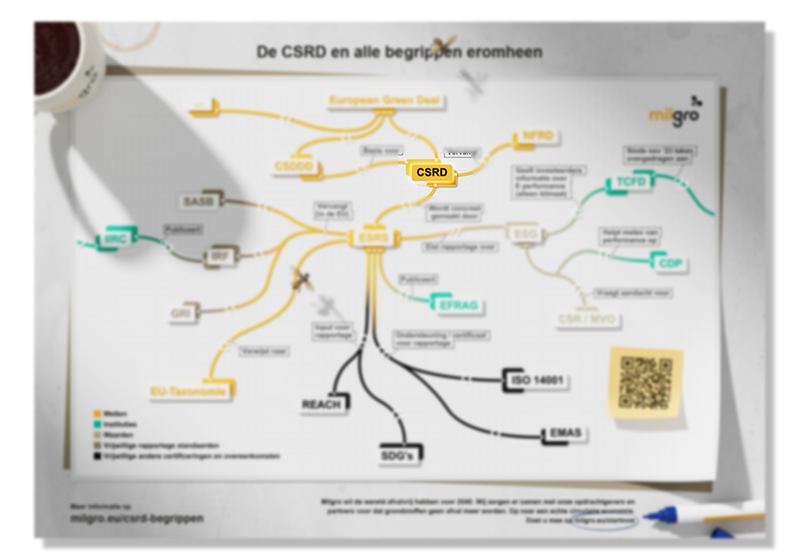Changing laws and regulations require a new way of managing and reporting within organizations. Companies are no longer judged on their financial performance, but also on their impact on society and the environment. The dual materiality analysis helps organizations identify and understand both financial and impact materiality- making it an important part of sustainability reporting.
In this blog, you will read what dual materiality analysis entails and how it is applied in CSRD guidelines.
What is dual materiality analysis?
Dual materiality analysis means that companies gain insight into two sides of sustainability: on the one hand, how external factors-such as climate change or scarcity-affect the organization (financial materiality), and on the other, how their own activities impact people and the environment (impact materiality).
Under the CSRD, organizations must map both perspectives. Reporting is mandatory only on topics that are assessed as material from one or both perspectives.
What is financial materiality?
To make this concrete, we have prepared some examples.
- Trends in revenue: How do market dynamics or economic changes affect revenue?
- Risks and opportunities: What happens to your profits if raw materials become scarcer or more expensive?
- Laws and regulations: What costs arise from mandatory compliance with new legislation?
- Market developments: How do customers react to competitors' new products or services?
This is of particular interest to investors and shareholders. They want to understand how robust and profitable an organization can remain in changing circumstances.
What is impact materiality?
Impact materiality is about the broader impact the company has on its environment. Key aspects are:
- Environmental impact: For example, the use of natural resources and carbon emissions.
- Social impact: Consider the treatment of employees and contribution to local communities.
- Working conditions: Does the company operate with fair wages and safe working conditions?
- Ethical business practices: How does the company deal with integrity, such as anti-corruption?
- Community engagement: What positive or negative effects does the company have on local communities?
This perspective helps companies understand their obligations to society.
Why is a dual materiality analysis important?
A dual materiality analysis helps companies balance financial performance with social responsibility. This offers several advantages:
- Better risk management: You understand what risks you face and can anticipate them.
- Increased transparency: Stakeholders get a clear picture of what your organization does.
- Improved reputation: By taking responsibility, you strengthen trust in your brand.
- Sustainable operations: This offers opportunities to create value in the long term.
How do you conduct a dual materiality analysis step by step?
A successful dual materiality analysis requires a structured approach. Here are the key steps:
- Identify relevant issues: gather information on financial and impact issues that are important to your organization.
- Engage stakeholders: consult internal and external stakeholders to understand their perspectives.
- Prioritize issues: rank issues based on their importance and impact.
- Analyze data: use qualitative and quantitative methods to analyze data.
- Report findings: communicate results of analysis to all stakeholders.
- Implement actions: develop and implement strategies to address identified issues.
Need help? Take advantage of our free template. In it you will find, among other things, an easy-to-use spreadsheet that will guide you through the points of your dual materiality analysis.
How is the dual materiality analysis related to the CSRD?
The Corporate Sustainability Reporting Directive (CSRD) sets new requirements for sustainability reporting. Organizations must report on both financial and non-financial information. Only topics assessed as material-from one or both perspectives-must they report.
Right now there is a lot of movement around the CSRD: implementation deadlines are shifting and reporting requirements are being simplified. Read our Omnibus Package blog for a complete overview of the latest changes and follow us on LinkedIn for current updates.
Frequently asked questions about dual materiality
No. The first double materiality assessment is usually the most intensive, as it’s the first time you engage stakeholders, select topics, and analyze the data. After that, an annual update is generally sufficient. A full reassessment is only needed in case of major strategic or organizational changes.
Not for all organizations. Only large companies that fall under the CSRD are required to conduct a double materiality assessment that applies to them. However, more and more organizations are choosing this approach voluntarily — for example, because investors demand transparency on ESG risks, customers and supply chain partners set sustainability requirements, or they want to prepare their organization for future legislation.
Determining material topics starts with identifying all potentially relevant themes. You can find an extensive list of these in the ESRS, among other sources. Next, you define a method to evaluate the materiality (i.e., significance) of each theme. It’s important to involve both your internal and external stakeholders in this process.
Each topic is assessed on two dimensions:
-
Impact materiality: How significant is your organization’s (positive or negative) impact on this topic?
-
Financial materiality: Does this topic present risks or opportunities for your organization’s financial performance?
Topics that are considered important on both dimensions are classified as double material.

Are you ready for the CSRD?
Getting started with the CSRD — and conducting a double materiality assessment — is no easy task. Many organizations struggle with interpreting and applying the requirements, especially now that additional obligations, such as the Omnibus Package, are being introduced.
Milgro is here to support your organization with practical tools and training. Visit our CSRD page to find everything you need to get started.
Stay informed
Want to stay up to date with the latest developments? Follow us on LinkedIn and Instagram or subscribe to our newsletter. Curious about what Milgro can do for your operations and waste process? Feel free to get in touch .














